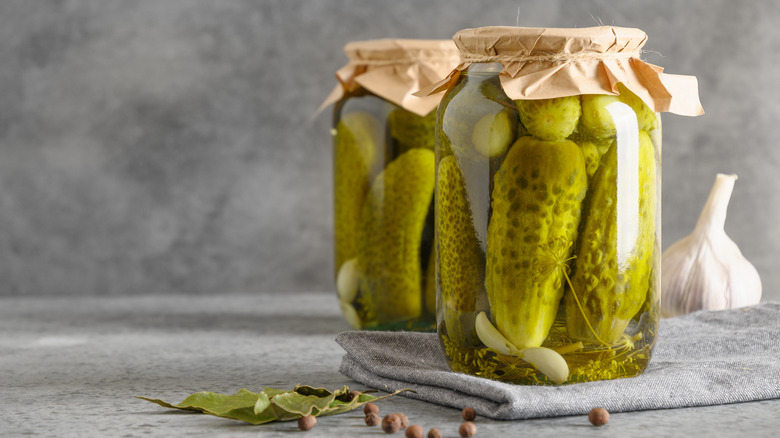The Part Of The Cucumber You Must Remove When Making Pickles
We're a nation of pickle people whether it's dill, gherkin, bread and butter. In fact, the average American eats over 9 pounds annually, notes Zippia. Although all sorts of dill-flavored treats exist, from potato chips to craft beers, there's nothing better than a pickle in its purest form. But, when it comes to a homemade jar, there's one important thing to do during pickle prep. Keep the cukes whole or cut them into spears or chips, just don't forget to remove this one part of the vegetable.
Pickling pros will confirm that there are two main ways that the briny bites can be made. Allrecipes shares that they can be made either through lacto-fermentation, which requires a salty brine and time or with a vinegar-based brine and a quick hot water bath. Regardless of the process, the resulting pickle always boasts acidity that makes for the ultimate snack or secret weapon in a range of recipes. For instance, while the brine can be used in a meat marinade or add zing to dressings and cocktails, pickles themselves can add a vinegary kick when mixed into tuna or potato salads, added to cheeseburger-inspired casseroles, or simply used as the star ingredient in a pickle soup!
However, before you can munch on these zesty veggies, pay attention to how you prep. Forgetting to remove one part of your cucumbers can make all the difference in the success (or failure) of your recipe.
Remove the blossom end for crisp pickles
Whether you like a zesty, garlicky, or sweet pickle, the way you prep your cucumbers will make all the difference in making sure they maintain a satisfying crunch. While fresh produce is always a good place to start, slicing the blossom end of your cucumbers can also help. According to Penn State, cucumber blossoms contain an enzyme (pectinase) that can cause pickles to soften significantly, but this can be avoided by cutting off 1/16 of an inch from the blossom base (via National Center for Home Food Preservation).
Unsure how to tell which end is the blossom base? If you harvest your own cucumbers, then the blossom end will be on the opposite end of where the stem is. Store-bought cukes can be a bit trickier. Grow Organic explains that you can instead inspect both ends of a cucumber, paying close attention to a rough dot rather than a smooth, indented dot characteristic of the stem base. If all else fails, cutting off both ends can give you some extra security.
Moreover, to maintain crispness after removing the blossom end, Penn State recommends storing the veggies in cold water to uphold the cucumber's pectin and avoid mushiness — but even adding a tannic grape leaf can inhibit pectinase from untrimmed cukes. Happy pickling!

